
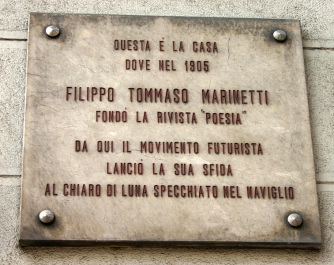
F.T. Marinetti launched the magazine Poesia, and the Futurist movement, in 1905. The plaque in Milan commemorates the magazine’s founding.
Liberating the word.
At the turn of the 20th Century, technology quickly advanced across Europe and the United States. As science and engineering displayed life-altering potential, ever-faster automobiles sped people over vast distances, new tools for mass production eased the burdens of a factory worker, and growing cities filled with the buzz of machinations. The hope? That advances in technology would allow humans to enter lives of leisure.
Artists were also invested in the potential of technology, and the Futurists were the most prominent voice for progress. The Italian Futurists, led by F.T. Marinetti, heralded war and revolution as a means to hasten the arrival of a new society, and demanded the destruction of any relic of the past, whether a museum or an old city like Venice. With manifestos in hand, the Futurists had a plan to thrust all areas of life – from poetry to the culinary arts – into modernity.
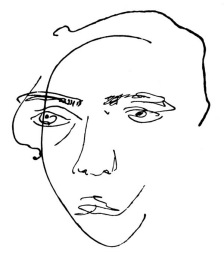
The Russian Futurists, led by Velemir Khlebnikov, embraced aesthetic advances in language and the visual arts. Velemir Khlebnikov, Self-Portrait
Like their Italian brethren, the Russian Futurists were highly invested in developing art as a reflection of modern technological (and thus, social) advances, but were less concerned with a complete overhaul of life. Instead, the Russian Futurists embraced aesthetic advances in language and the visual arts. Led by Velemir Khlebnikov, this movement strived to free language from the constraints of meaning and significance, instead considering sound as being of primary importance. This poetry, called Zaum, utilized neologism and glossolalia, among other devices, to let language resist coherence in its quest to be material building blocks for complex soundscapes. The Zaum poets used these tactics to display language as more than a medium for communication, letting words resist coherence in order to become the building blocks for complex sounds.
Although Zaum poets like Aleksei Kruchenykh, Vladimir Mayakovsky, and Yelena Genrikhovna Guro were less concerned with language’s use as a means for practical communication, the words in their poems could be pulled apart and interpreted, the meaning highlighting the auditory experience of the audience. Their method of contorting language to display interesting sounds (instead of clever considerations of the world) illustrates an early advance towards synthetic poetry. Here, the poet loosens control of what is being expressed in order to build an interesting sound experience for the audience. By producing poems that promoted the auditory experience as the primary goal, this movement helped provide a foundation for synthetic poetry. Readers began to understand material language as an aesthetic experience unto itself, with the work’s meaning being a secondary concern.
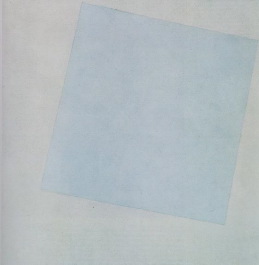
Kazimir Malevich’s White on White illustrates the Futurist’s blend of materials that draw attention to the nature of the color itself, and not necessarily to what the color represents. |
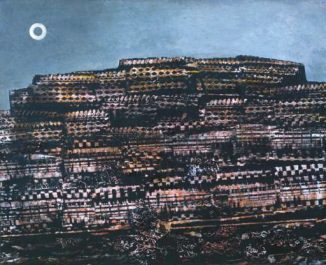
Max Ernst’s 1934 painting, The Entire City, employed the Surrealist technique of grattage, which involved scraping off dry pieces of paint, resulting in random lines and shapes. |
Seeking the subconscious.
Differing from the methods of the Futurists, the Surrealists experimented with creating poetry and art that discovered and explored subconscious thoughts and connections for both the writer and the reader. In his 1924 "Manifesto of Surrealism," André Breton pronounced, "I would like to sleep in order to surrender myself to the dreamers, the way I surrender myself to those who read me with eyes wide open; in order to stop imposing, in this realm, the conscious rhythm of my thought." For Breton, conscious, rational thought only served as controls for social and political norms. Thus, Breton wanted Surrealists to tap their dream worlds to encourage liberation from logic and rationale.
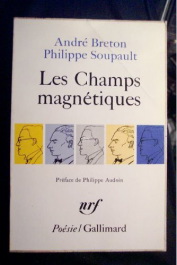
Andre Breton and Phillipe Soupault created Les Champs Magnetiques as the first Surrealist novel to employ automatic writing.
Breton, Paul Valéry, Pierre Reverdy, Robert Desnos and various other members of the movement devised experiments (and appropriated those from other movements, such as Dada) to assist writers in losing conscious control of the creative process, causing spontaneous development and arrangement of images and ideas.
The most popular experiment for Surrealists dealt with automatism or automatic writing, which attempted to shift control of the creative process from the conscious to the subconscious mind. In an attempt to enter a trance-like state, the writer let his or her hand control the creation of language. In a collaborative effort, Breton and Phillipe Soupault created Les Champs Magnétiques as the first Surrealist novel to employ automatic writing. Beyond automatic writing, the Surrealists were also interested in various other experiments, such as calligrammes and cut-ups, as a means to free artists from the constraints of logic and discover their unconscious dream world. As a result, Surrealist writing displayed strange connections and transgressions for the reader to deliberate over. So, while the Futurists let language exist as medium for an auditory experience, the Surrealists worked with language as a method to tap the subconscious. Here, meaning was also rendered a secondary concern, following the primary goal of expressing inner thoughts and experiences, however strange or unrelated.
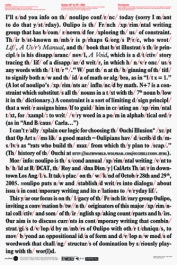
In La disparition, Georges Perec sustained a lipogram by eliminating the letter "e" throughout his novel.
Recognizing potential.
While the Surrealists left production to the inner workings of the mind, other writers explored the role of formal constraints in developing interesting pieces of art. For hundreds of years, forms such as the sonnet, ode, and villanelle were regarded as the pinnacle of poetic writing. The merits of a poem were easily judged by how well the words flowed through the structure. On November 24th, 1960, a group was chartered to redirect writers away from traditional forms and towards the potential of science and mathematics. This collaboration between writers, poets, and mathematicians was named the Ouvroir de littérature potentielle (or, simply, OuLiPo), and was dedicated to creating new structures and forms for writers.
In "Lipo: First Manifesto," François Le Lionnais questions the focus on traditional forms by inquiring, "Should humanity lie back and watch new thoughts make ancient verses?" Georges Perec thought not, and in La disparition sustained a lipogram by eliminating the letter "e" throughout his novel, which detailed the search for a missing individual. Every piece of writing from an Oulipian was written under a particular constraint, though the restrictions are not always easily identified by a reader. A contemporary example of an Oulipian constraint can be seen in the popular Fibonacci poems. In sixth grade, New York City student Georgia Luna Smith Faust became fascinated with the Fibonacci sequence – nature’s underlying form of growing patterns. Years later, she tied together those two eternal bookends, mathematics and poetry, in yet another way. Note the syllable sequence per stanza, which is a Fibonacci sequence: 1+1+2+3+5+8+13… before it rolls down and repeats to form a pair of perfect syllabic pyramids. Fibonacci poetry has gestated into a mini-movement, with recent articles in the New York Times and Hyperseeing, the math/art journal. It even has its own experimental website and archive of Fibonacci poetry, fibetry.com.
This
is
fear of
known inept
comfort level of
pigeons rodents fire crackers
explosions of city things an inside/outside inbetween the middle of interior fear of what
might be found when is constant can
not or never would
be concrete
actions
lost
incon-
crete
patience
contentment
with current content
showerheads bathtubs in bathrooms
full and exploding won’t be any, any longerone can panic only in passing fear of focus
chaos chance encounters things we
love last little there
are no things
but con-
crete
things.
The Reader’s New Role
OuLiPo wasn’t only established as a service for poets and writers. Just as the Futurists required that the audience make sense of their neologisms and new words, and just as the Surrealists performed experiments and played games to unlock their own subconscious thoughts, the Oulipians created language systems and literature, the potential of which could be unfurled by a reader. They hoped their audience would recognize and rework the material language as a means to discover meanings embedded in the Oulipians’ work.
Raymond Queneau, one of the most inventive Oulipians, was both a mathematician and writer. His Cent mille milliards de poèmes (translated as One Hundred Million Million Poems) is a series of 10 sonnets that all have the same rhyme sound at the end of each line. He wanted to give readers the chance to take part in the creative process, forming sonnets that Queneau himself had not anticipated. Thus, readers can form new poems by rearranging any line from one sonnet with any line from the other sonnets, providing 1 billion potential poems – more than any individual could read in a lifetime.
Beyond creating forms to reflect 20th century advances in science and thought, OuLiPo also experimented with 20th century technologies as a means to create art. In doing so, they inspired a new generation of writers to employ digital mediums that can loosen a writer’s control of a text while allowing computers to create content and readers to unlock the potential of a work.
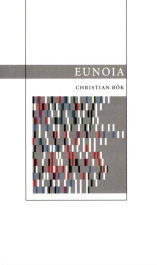
The cover of Christian Bök’s 2001 book-length lipogram, Eunoia. The image is a polychromatic translation of Arthur Rimbaud’s "Voyelle." The various colors follow the pattern of vowel sounds throughout the poem, reminiscent of an Oulipian language constraint thrust into the visual realm. |

Synthetic poetics is unlocking new potential in the digital realm, as poets and programmers are discovering innovative ways to generate and display language. |
Letting go of the printed page.
The 21st century finds readers clutching to the printed page, attached to the tactile experience of leafing through a new edition and giving the binding a solid crack before settling into a story, essay, or poem. This nostalgia for print is heightened by signs of its disappearance. Bulky encyclopedias have become obsolete, thanks to easily searchable versions available on the web. Newspaper circulation is down, while Internet readership booms. Entire libraries are being digitized for easy access. With artisan presses and experimental book design, print will continue, but the Digital Age is offering new possibilities for the language arts. But is there merit in computer-aided and computer-generated poems? Don’t these disrupt or eliminate a poet’s intent?
By looking at the short history of the precursors to synthetic poetry, computer-aided productions can be seen as another point on the line of new potential for the language arts. Synthetic poetics is unlocking new potential in the digital realm, as poets and programmers are discovering innovative ways to generate and display language. Just as the Futurists would have wished, language can audibly and visually blend on an animated page. Just as the Surrealists would have hoped for, computer generated poems help us question our own subconscious and the consciousness of machines, and thus our place in the world. And just as the Oulipians continue to experiment with mathematics, new, digitized algorithms are pushing the potential for formal constraints.
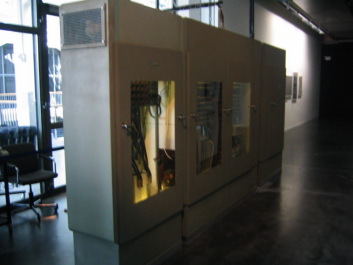
In 1959, Theo Lutz used a Zuse Z22 computer to generate a stochastic poem
Dual directions.
Digital poetries move in two general, though not mutually exclusive, directions. One focuses on the artist transferring control of the work to a computer. Much like the cut-up poems created by Dada and the Surrealists, a computer can be given several semantic targets and rearrange undetermined language into a stochastic poem. In 1959, Theo Lutz utilized a Zuse Z22 (an early computer using vacuum tubes) to generate a stochastic text using certain nouns from Kafka’s The Castle, later connecting them by consistent grammatical rules. One result was the following poem, found in an article published in the journal Augenblick:
Not every look is near. No village is late.
A Castle is free and every farmer is distant.
Every stranger is distant. A day is late.
Every house is dark. An eye is deep.
Not every castle is old. Every day is old.
Not every guest is furious. A church is narrow.
No house is open and not every church is quiet.
Not every eye is furious. No look is new.
Certainly, the lines don’t flow mellifluously, and the sentence structure is simple. The connections, however, are quite interesting. Could "A castle is free and every farmer is distant" be interpreted as a consideration of the feudal system? How does this poem work as a companion to Kafka’s original? Or, is aesthetic merit awarded merely on the basis that the poem came from a machine?
At the least, computer-generated poems have caused writers and critics to question the merits of poems created by people. For over five years, Pablo Gervás and his team of researchers at the Universidad Complutense de Madrid have been working to create a computer-based poem generator that can understand how to manipulate phonetics, diction, comparison, theme, and emotional tension into an aesthetically pleasing work of art. Other researchers, such as Ruli Manurung, have focused on single aspects of generating poems, such as meter. Manurung successfully programmed software to write a stochastic poem that adheres to the traditional meter of a limerick:
The cat is the cat which is dead.
The bread which is gone is the bread.
The cat which consumed
the bread is the cat
which gobbled the bread which is gone.
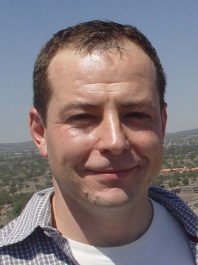
Pablo Gervas and his team of researchers at the Universidad Complutense de Madrid have been working to create a computer-based poem generator. |
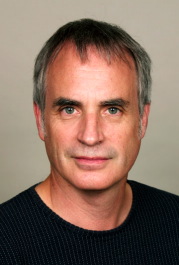
John Cayley suggests that computer programming codes can be appreciated for both the potential for the code and the aesthetics that the code contains in its potential state. |
While this unrhymed limerick doesn’t satisfy each of Gervás’s qualifications for a poem, given that the target words were "cat," "dead," "bread," "gone," "eat," and "past," it is a significant advancement in computer-generated poetry. The program was able to analyze and coordinate the stressed and unstressed syllables of a limerick, and generate sentence structure that’s much more complex than Lutz’s computer-generated poem.
Even though researchers have yet to develop software that can replicate a poet’s role, digital technology is heavily influencing many language artists, which leads to a second strand of digital poetry. Here, poets like John Cayley and Jim Rosenberg step beyond paper and display their language on the dynamic canvas of the screen, while Aya Karpinsky and Brian Kim Stefans produce innovative poems that put language in motion, whether as a digital projection against the wall or movable type on a ever-advancing digital page.
Redefining language.
If presentation of the digital page is altering the way we perceive language, to what extent can aesthetic pleasure be derived from the new building blocks of these poems – the code itself?
Programming languages are, by name, languages, though they’re not necessarily used to communicate between peoples. Instead, these languages express different potential for meaning. A knowledgeable audience, then, should be able to value code for what the code represents.
In his 2002 "The Code is not the Text (Unless it is the Text)," published in the Electronic Book Review, John Cayley suggested that digital writing should be constructed for reading on two levels: the communicable language on the screen and the programmed language that presents what we see on screen. Cayley proclaimed, "If a codework text, however mutually contaminated, is read primarily as the language displayed on a screen then its address is simplified. It is addressed to a human reader who is implicitly asked to assimilate the code as part of natural language." He posited that programming codes are always addressed to a machine that must translate the code, and that programming codes are always readable by certain individuals who understand the language and can appreciate both the potential for the code and the aesthetics that the code contains in its potential state. Cayley then presented his own experiments with a coding language called, HyperTalk. Notice how many of the commands provide central roles in your understanding of the text:
on write
repeat twice
do "global " & characteristics
end repeat
repeat with programmers = one to always
if touching then
put essential into invariance
else
put the round of simplicity * engineering / synchronicity + one into invariance
end if
if invariance > the random of engineering and not categorical then
put ideals + one into media
if subversive then
put false into subversive
end if
if media > instantiation then
put one into media
end if
else
put the inscription of conjunctions + one into media
end if
Overall, if the computer is not ready to produce poems that satisfy our sense of aesthetics, both humans and machines are at least prepared to appreciate poems such as these, which combine our interests in language as both experience and function.
